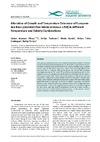Identificador persistente para citar o vincular este elemento:
https://accedacris.ulpgc.es/handle/10553/60015
| Campo DC | Valor | idioma |
|---|---|---|
| dc.contributor.author | Yilmaz, Hatice Asuman | - |
| dc.contributor.author | Turkmen, Serhat | - |
| dc.contributor.author | Kumlu, Metin | - |
| dc.contributor.author | Eroldogan, Orhan Tufan | - |
| dc.contributor.author | Perker, Nafiye | - |
| dc.date.accessioned | 2019-12-30T13:21:59Z | - |
| dc.date.available | 2019-12-30T13:21:59Z | - |
| dc.date.issued | 2020 | - |
| dc.identifier.issn | 1303-2712 | - |
| dc.identifier.other | Scopus | - |
| dc.identifier.uri | https://accedacris.ulpgc.es/handle/10553/60015 | - |
| dc.description.abstract | This study was performed to assess the combined effects of three salinities (0, 20 and 38 ppt) and three acclimation temperatures (15, 20 and 25°C) on growth performance, proximate composition and thermal tolerance of European Sea Bass (32 g) inhabiting southern parts of the Mediterranean Sea. Highest fish final weight (83.8 g) was achieved at 25°C in freshwater (FW). Specific growth rate (SGR) at 25°C was about twice higher than that at 15°C, while 20°C promoted an intermediate growth. The fish cultured in FW at 25°C displayed consistently lower FCR and better SGR than those in full strength seawater (SW). Salinity had strong influence on fillet protein and lipid compositions. Highest lipid content (14.9%) was found in fish held in brackish water (20 ppt), and the fish held in SW had the lowest lipid content. CTMin and CTMax values ranged from 3.26°C to 7.33°C and from 31.81°C to 36.68°C, respectively. The thermal tolerance results indicated that European sea bass is more sensitive to high rather than low temperatures. These results suggested that this species can be farmed in stagnant SW deep ponds with high ambient temperatures during hot summer months in southern parts of the Mediterranean. During cold winter months, however, this fish can be successfully cultured in low salinities or even in FW. | - |
| dc.language | eng | - |
| dc.relation.ispartof | Turkish Journal of Fisheries and Aquatic Sciences | - |
| dc.source | Turkish Journal of Fisheries and Aquatic Sciences [ISSN 1303-2712], v. 20, p. 331-340 | - |
| dc.subject | 251092 Acuicultura marina | - |
| dc.subject.other | CTMin | - |
| dc.subject.other | CTMax | - |
| dc.subject.other | Brackish water | - |
| dc.subject.other | Growth Performance | - |
| dc.subject.other | Thermal polygo | - |
| dc.title | Alteration of growth and temperature tolerance of european sea bass (Dicentrarchus labrax linnaeus 1758) in different temperature and salinity combinations | - |
| dc.type | info:eu-repo/semantics/Article | - |
| dc.type | Article | - |
| dc.identifier.doi | 10.4194/1303-2712-v20_5_01 | - |
| dc.identifier.scopus | 85074800036 | - |
| dc.identifier.isi | 000500598300001 | - |
| dc.contributor.authorscopusid | 48461962400 | - |
| dc.contributor.authorscopusid | 36150331400 | - |
| dc.contributor.authorscopusid | 6701669197 | - |
| dc.contributor.authorscopusid | 6602566178 | - |
| dc.contributor.authorscopusid | 57211666275 | - |
| dc.identifier.eissn | 2149-181X | - |
| dc.description.lastpage | 340 | - |
| dc.identifier.issue | 5 | - |
| dc.description.firstpage | 331 | - |
| dc.relation.volume | 20 | - |
| dc.investigacion | Ciencias | - |
| dc.type2 | Artículo | - |
| dc.contributor.daisngid | 29666253 | - |
| dc.contributor.daisngid | 31655267 | - |
| dc.contributor.daisngid | 1187936 | - |
| dc.contributor.daisngid | 29383815 | - |
| dc.contributor.daisngid | 32040175 | - |
| dc.description.numberofpages | 10 | - |
| dc.utils.revision | No | - |
| dc.contributor.wosstandard | WOS:Yilmaz, HA | - |
| dc.contributor.wosstandard | WOS:Turkmen, S | - |
| dc.contributor.wosstandard | WOS:Kumlu, M | - |
| dc.contributor.wosstandard | WOS:Eroldogan, OT | - |
| dc.contributor.wosstandard | WOS:Perker, N | - |
| dc.date.coverdate | Mayo 2020 | - |
| dc.identifier.ulpgc | Sí | es |
| dc.description.sjr | 0,343 | |
| dc.description.jcr | 1,264 | |
| dc.description.sjrq | Q3 | |
| dc.description.jcrq | Q3 | |
| dc.description.scie | SCIE | |
| item.fulltext | Con texto completo | - |
| item.grantfulltext | open | - |
| Colección: | Artículos | |
Citas SCOPUSTM
29
actualizado el 08-jun-2025
Citas de WEB OF SCIENCETM
Citations
26
actualizado el 08-jun-2025
Visitas
429
actualizado el 30-nov-2024
Descargas
303
actualizado el 30-nov-2024
Google ScholarTM
Verifica
Altmetric
Comparte
Exporta metadatos
Los elementos en ULPGC accedaCRIS están protegidos por derechos de autor con todos los derechos reservados, a menos que se indique lo contrario.
